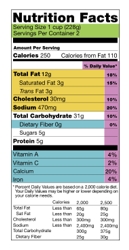|
||||||||||
 |
|
| June 03, 2013 | To ensure delivery of this email, please add newsletter@hairboutique.com to your contacts. |
Fat Free Products That Aren't  This Week's Coupon, Save 20%: RADIANTBEAUTY20 Many people watching their weight or trying to lose some excess pounds study food labels. What many consumers may not realize is that in many cases they think they’re consuming fat free products that aren’t fat free at all. In fact, not only are the fat free products not fat free, they’re loaded with hidden fat and calories. Food labels deceive the best of us. In fact, if you take a really close look you might be horrified to discovered that a food you think only has 100 calories has two or three times more. FDA Labeling Concerns Confusing or mislabeled food labels are nothing new. In fact, the US Food and Drug Administration (FDA) announced a major change in nutrition labeling requirements back in the summer of 2003. One of the primary triggers for the FDA’s new food labeling requirements was their goal of exposing the amount of artery-clogging trans fats hidden in a lot of products. Part of the blame for the increasing rates of obesity in the In the real world, a bag of chips may be considered one serving when in reality it’s two or three. Which means three times the suggested portion. Also, calorie information listed on some labels often understate how much food consumers are really putting into their mouth. Confusion Over Portion Control
Inconsistent labeling is another problem. Not all slices of pie or cake are created equal. In one case, a slice of pie equals one-tenth of the pie while in another case it equals one-eight of the pie. To the naked eye both pieces of pie look very similar in size, but can be very different in calories. Serving size and inconsistent labeling are just two of the common problems which add to the confusion consumers experience when trying to decipher food labels. Secret Ingredients Other factors which confuse consumers trying to decipher food labels include a list of secret ingredients on the label which aren’t actually included in the food. Since companies want to give their foods the essence of healthiness they may list fruits or similar healthy ingredients on the label when it’s artificial flavoring. Or the product may contain fruit, but only a small amount compared to fruit syrup and.or juice. The percentage of actual ingredients may be carefully disguised. Finally, the weight on the products may actually be more than what is listed on the label, which also adds hidden calories. Summary - Fat Free Products That Aren’t No wonder consumers struggle with watching their weight. Serving sizes may not be true to real world portions, calorie information may be Different labels on food that clearly display the total number of calories and nutrients in the entire package, rather than just part of it, might help people make healthier food choices, according to a study from the U.S. Food and Drug Administration.T The Journal of the People also did well when the nutritional information was presented for both one serving and the entire container. |
| If you would like to consult with Karen personally about any of your hair care questions, please see our Ask Karen page. We would love your feedback about this newsletter! Share your thoughts and ideas with us! |
 |
 |
 |
 |
 |
 |
| Copyright 1997-2009, hairboutique.com, All Rights Reserved. Terms of Service, Privacy Statement, Advertise, Contact Us, Press |
| Please note that you are receiving this mail because in the past you signed up for the HairBoutique.com mailing list. This mailing is in full compliance with U.S. Federal requirements for commercial e-mail under bill s.1618 Title 111, Section 301, Paragraph (a) (2) (c) passed by the 105th U.S. Congress. |



 One of the most misleading areas of portion control is with foods specifically packaged to be single servings. Except in reality a single serving muffin might actually contain 2-3 servings. Most people see a small muffin, assume that it is indeed a single serving and don’t stop to figure out that the label states it’s multiple servings.
One of the most misleading areas of portion control is with foods specifically packaged to be single servings. Except in reality a single serving muffin might actually contain 2-3 servings. Most people see a small muffin, assume that it is indeed a single serving and don’t stop to figure out that the label states it’s multiple servings. misrepresented, the ingredient list may include secrets and the weight of a product or serving size can be off by 20% more or less. It explains why there’s fat free products that aren’t fat free at all.
misrepresented, the ingredient list may include secrets and the weight of a product or serving size can be off by 20% more or less. It explains why there’s fat free products that aren’t fat free at all.
